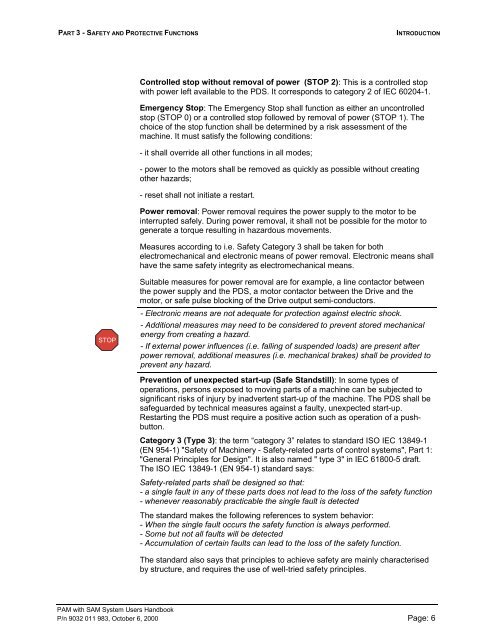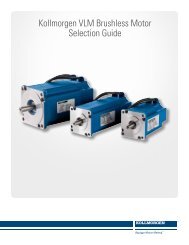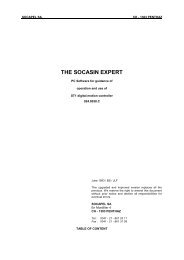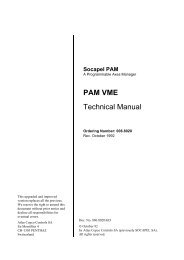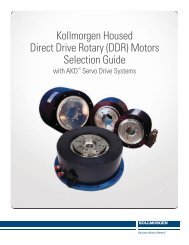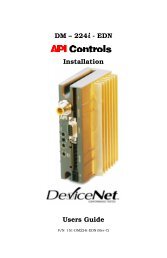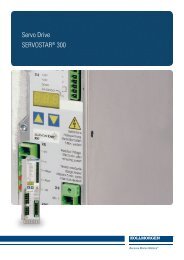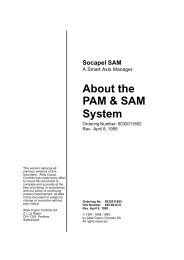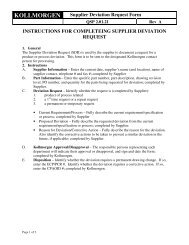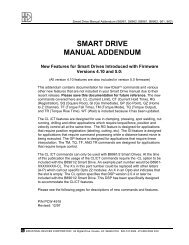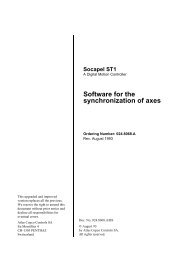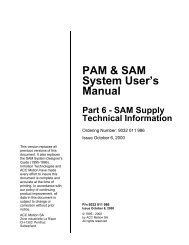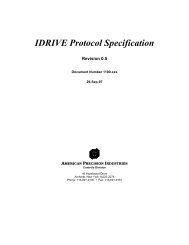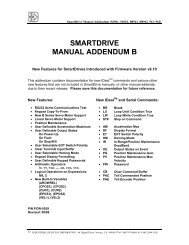PAM & SAM System User's Manual Part 3: Safety and ... - Kollmorgen
PAM & SAM System User's Manual Part 3: Safety and ... - Kollmorgen
PAM & SAM System User's Manual Part 3: Safety and ... - Kollmorgen
Create successful ePaper yourself
Turn your PDF publications into a flip-book with our unique Google optimized e-Paper software.
PART 3 - SAFETY AND PROTECTIVE FUNCTIONS<br />
INTRODUCTION<br />
Controlled stop without removal of power (STOP 2): This is a controlled stop<br />
with power left available to the PDS. It corresponds to category 2 of IEC 60204-1.<br />
Emergency Stop: The Emergency Stop shall function as either an uncontrolled<br />
stop (STOP 0) or a controlled stop followed by removal of power (STOP 1). The<br />
choice of the stop function shall be determined by a risk assessment of the<br />
machine. It must satisfy the following conditions:<br />
- it shall override all other functions in all modes;<br />
- power to the motors shall be removed as quickly as possible without creating<br />
other hazards;<br />
- reset shall not initiate a restart.<br />
Power removal: Power removal requires the power supply to the motor to be<br />
interrupted safely. During power removal, it shall not be possible for the motor to<br />
generate a torque resulting in hazardous movements.<br />
Measures according to i.e. <strong>Safety</strong> Category 3 shall be taken for both<br />
electromechanical <strong>and</strong> electronic means of power removal. Electronic means shall<br />
have the same safety integrity as electromechanical means.<br />
STOP<br />
Suitable measures for power removal are for example, a line contactor between<br />
the power supply <strong>and</strong> the PDS, a motor contactor between the Drive <strong>and</strong> the<br />
motor, or safe pulse blocking of the Drive output semi-conductors.<br />
- Electronic means are not adequate for protection against electric shock.<br />
- Additional measures may need to be considered to prevent stored mechanical<br />
energy from creating a hazard.<br />
- If external power influences (i.e. falling of suspended loads) are present after<br />
power removal, additional measures (i.e. mechanical brakes) shall be provided to<br />
prevent any hazard.<br />
Prevention of unexpected start-up (Safe St<strong>and</strong>still): In some types of<br />
operations, persons exposed to moving parts of a machine can be subjected to<br />
significant risks of injury by inadvertent start-up of the machine. The PDS shall be<br />
safeguarded by technical measures against a faulty, unexpected start-up.<br />
Restarting the PDS must require a positive action such as operation of a pushbutton.<br />
Category 3 (Type 3): the term “category 3” relates to st<strong>and</strong>ard ISO IEC 13849-1<br />
(EN 954-1) "<strong>Safety</strong> of Machinery - <strong>Safety</strong>-related parts of control systems", <strong>Part</strong> 1:<br />
"General Principles for Design". It is also named " type 3" in IEC 61800-5 draft.<br />
The ISO IEC 13849-1 (EN 954-1) st<strong>and</strong>ard says:<br />
<strong>Safety</strong>-related parts shall be designed so that:<br />
- a single fault in any of these parts does not lead to the loss of the safety function<br />
- whenever reasonably practicable the single fault is detected<br />
The st<strong>and</strong>ard makes the following references to system behavior:<br />
- When the single fault occurs the safety function is always performed.<br />
- Some but not all faults will be detected<br />
- Accumulation of certain faults can lead to the loss of the safety function.<br />
The st<strong>and</strong>ard also says that principles to achieve safety are mainly characterised<br />
by structure, <strong>and</strong> requires the use of well-tried safety principles.<br />
<strong>PAM</strong> with <strong>SAM</strong> <strong>System</strong> Users H<strong>and</strong>book<br />
P/n 9032 011 983, October 6, 2000 Page: 6


